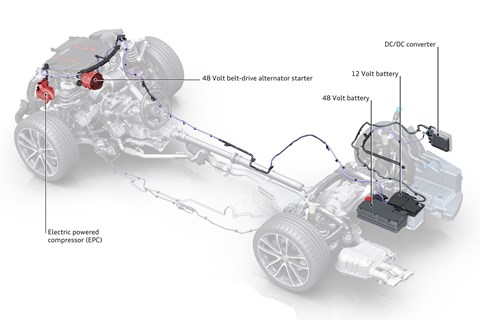► Audi’s new V6 diesel explained
► Engine used for growing S range
► What makes it different?
Audi is rolling out its punchy new 3.0-litre V6 diesel faster than you can say ‘particulate filter’ – and boldly replacing previous high-performance petrol models in the process.
The engine block is based on the ’50 TDI’ engine already in service in many Audis, but it’s been heavily revised. Uprated crankshaft, pistons, conrods and oil-temperature management, plus an electrically powered compressor (EPC) are the most notable differences.
The engine now puts out up to 344bhp and 516lb ft. That’s a chunky 58bhp and 59lb ft increase over a 50 TDI, but falls 100bhp short of the old petrol V8 in the S6 and S7. Torque, however, is up 111lb ft on the old V8, for a huge midrange kick. The SQ5 also makes the switch back to TDI power after its two-year dabble with a 3.0-litre petrol V6, with the S4 and S5 using the engine now, too.

With the SQ5, the news is easier to swallow: just 7bhp less, almost 150lb ft more, and increased fuel efficiency too. We’ve driven all three cars and come away mightily impressed by the new TDI powertrain. And that electrically powered compressor has proved key.
The ace card
The SQ7’s monstrous V8 diesel was first to debut the same kind of electrically powered compressor as found on the new V6 TDI. Audi says the unit ‘visually resembles a conventional turbocharger’ despite not using exhaust gases.
Instead, the EPC is designed to counteract turbo lag by responding to big thumps of throttle either from a standstill or at low engine speeds. If the engine thinks the extra boost is required, it closes a bypass valve, directing air through the compressor.
The compressor can respond in as little as a quarter of a second and spools up to a maximum speed of 70,000rpm. It then feeds the compressed air into the combustion chamber. It allows the V6 diesel to respond more promptly and expand the torque band, with the maximum 516lb ft available between 2500 and 3100rpm.
Hybrid help
As is the growing (and emissions-minimising) trend, Audi’s sporty diesel uses 48-volt mild-hybrid assistance as a complement to the compressor.

While the EPC is there to boost performance, the integrated belt-driven starter-generator and a 10Ah lithium-ion battery pack – which is neatly packaged underneath the boot floor – add extra efficiency to the turbodiesel powertrain.
It allows engine coasting for up to 40 seconds a time and for the start/stop system to kick in at up to 13mph when you’re coming to a stop. Along with the reduction in cylinder count and switch to compression ignition, the mild-hybrid tech helps boost fuel efficiency over the S6’s V8 predecessor, as well as petrol-powered contemporaries such as the Mercedes-AMG E53 or BMW 540i xDrive.
Audi’s S TDI: how it works
Not what it seems
Electric compressor looks like a turbo, but isn’t. It’s set behind the intercooler on the intake path.
Spin cycle
Compressor responds in 250 milliseconds and spins at up to 70,000rpm, helping eliminate turbo lag.
Teamwork = dream work
A 48v mild-hybrid system allows for coasting to balance EPC’s power boost.